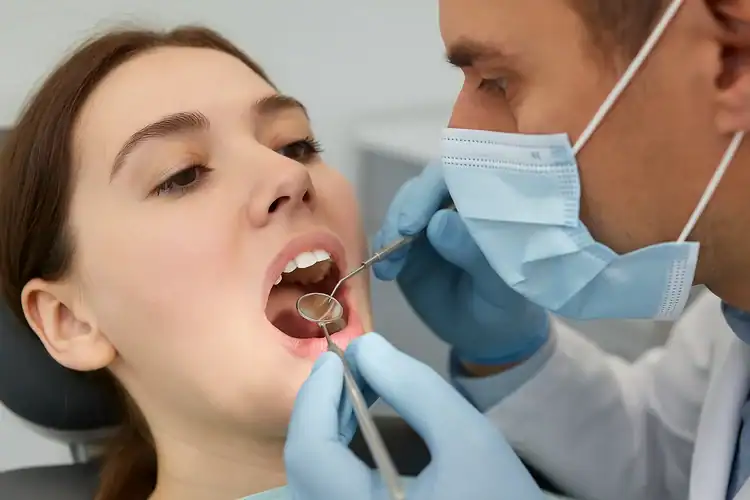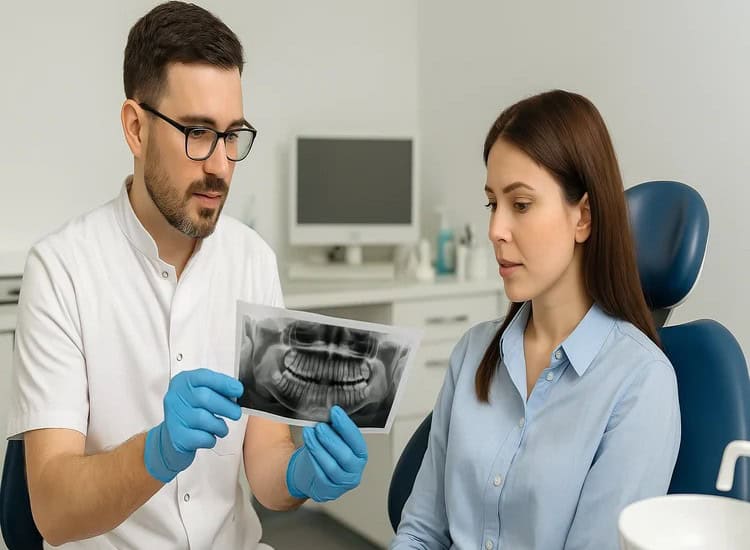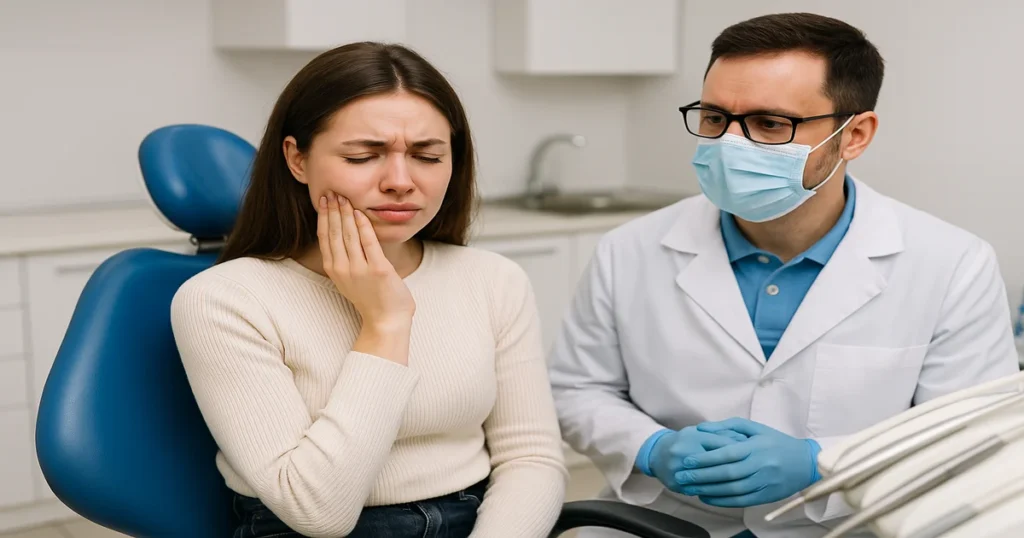Experiencing discomfort or sensitivity after a dental filling is common. Your tooth needs time to adjust to the new filling material, and mild pain or heightened sensitivity is often a normal reaction in most cases.
In this article, we explore the reasons behind tooth pain after filling, how to tell when it’s normal versus problematic, strategies to manage discomfort, and tips to support overall tooth health, including safe oral care practices. You’ll also see how the type of filling material and your oral habits can influence recovery.

Understanding the Common Causes of Tooth Pain After a Filling and Why It Happens
In order to understand the causes of tooth pain after a dental filling, you must take a look at the main reasons, which are demonstrated below:
Pulp Irritation and Sensitivity
One of the primary reasons for tooth pain after a filling is pulp irritation. During the procedure, the inner tissue of the tooth can become inflamed as it reacts to the drilling and placement of the filling material. This inflammation can cause temporary discomfort or sensitivity, especially when consuming hot or cold foods. The filling materials, composite, amalgam, or glass ionomer, can also influence the degree of sensitivity, as each material interacts differently with the natural tooth structure.
Bite Adjustment and Occlusion Changes
After a filling, your bite may feel slightly different, especially if the filling alters the tooth’s surface height. Minor bite misalignments can result in pressure points when chewing, leading to discomfort. Proper adjustment by your dentist ensures your bite remains balanced, but mild pain during the first few days is common as your jaw adapts if you follow the proper care for braces.
Preexisting Tooth Conditions
Sometimes, tooth pain after a filling is exacerbated by underlying dental issues that were not visible before the procedure, such as small cracks, decay in neighboring teeth, or enamel weakening. Patients who already experience tooth sensitivity may notice stronger reactions as the nerve responds to temperature changes or pressure. Maintaining consistent oral care habits at work and at home can help mitigate additional stress on the treated tooth.
Microleakage or Filling Gaps
In rare cases, microscopic gaps between the filling and the natural tooth can allow bacteria or fluids to irritate the pulp. This can cause prolonged discomfort or heightened sensitivity. If symptoms persist beyond the normal healing period, your dentist may need to evaluate the filling for adjustments or replacement if you are dealing with tooth sensitivity.
Post-Procedure Healing Process
It’s essential to remember that some level of pain is a natural part of the healing process. The body naturally responds to trauma, and nerves inside the tooth may take several days to settle after the filling is placed. Patients who follow proper recovery steps, such as avoiding very hard or sticky foods, gentle brushing, and flossing, often experience a faster resolution of discomfort. Maintaining a good routine of dental check-ups also ensures any minor issues are detected early.
Recognizing When Pain After a Filling is Considered Normal
Mild discomfort, occasional sharp twinges, or sensitivity to hot or cold foods is generally normal after a filling. These symptoms typically last from a few days to a week as the tooth adjusts. Normal pain is usually mild, fades gradually, and responds to over-the-counter pain relievers.
However, pain that increases over time, persists beyond one to two weeks, or is accompanied by swelling or redness may indicate a more serious issue. Regular monitoring and following proper oral hygiene routines, including gentle brushing and rinsing, can help reduce prolonged sensitivity and support the healing process. Learning how to manage common tooth sensitivity effectively can also improve comfort.
Situations That Require Contacting Your Dentist About Post-Filling Pain
Persistent or severe pain may signal a problem such as pulp inflammation, an improperly fitted filling, or a hidden crack in the tooth. Contact your dentist if you notice:
- Pain that intensifies instead of fading
- Swelling, pus, or gum irritation around the treated tooth
- Difficulty biting or chewing without pain
- Ongoing sensitivity to hot or cold foods beyond the normal healing window
Early evaluation can prevent complications and may require interventions such as a root canal or filling adjustment. Recognizing these warning signs is crucial for a safe and effective recovery.

How to Effectively Manage Tooth Pain and Sensitivity After a Filling
Beforehand, you have to know that tooth pain after filling is completely normal and even authentic websites like Colgate have said this about tooth pain after filling:
“It’s relatively common for you to have some pain or sensitivity in the treated tooth after a filling.”
Managing post-filling discomfort involves several practical steps:
- Take over-the-counter pain relievers as directed.
- Avoid very hard, sticky, or overly sweet foods that place pressure on the filling.
- Maintain proper oral hygiene while protecting the treated area. Gentle brushing and rinsing with lukewarm water prevent irritation.
- Use a soft-bristle toothbrush and floss carefully to reduce the risk of additional cavities.
Combining these practices with a healthy oral routine helps limit pain and supports faster recovery. Patients who maintain consistent oral care habits often experience less discomfort and a more predictable healing process.
Contact Us for Help!
At Tsawwassen Family Dental, our experts provide precise fillings and personalized guidance to manage any post-filling discomfort safely.
Should I Worry If I have Tooth Pain after A Filling?
Tooth pain after a filling is typically mild and temporary, caused by pulp irritation, bite adjustments, or sensitivity to the filling material. Monitoring discomfort, following proper oral care routines, and avoiding harmful foods can minimize pain and support recovery.
At Tsawwassen Family Dental, our skilled team provides expert fillings and personalized guidance to help you manage post-treatment discomfort safely. If your tooth pain persists or worsens, we’re here to evaluate your tooth and ensure your oral health is fully restored. Schedule a consultation today to receive professional care and advice.
FAQ
Below are answers to common questions about tooth pain after a filling to help you understand what’s normal and when to seek professional care.
-
What are the possible causes of pain after a filling?
Causes include pulp irritation, minor bite changes, sensitivity to the filling material, and preexisting cracks or decay.
-
How long should tooth pain last after a filling?
Pain typically lasts a few days up to a week. Persistent or worsening pain beyond 1–2 weeks should be evaluated.
-
What should I do if my tooth pain doesn’t go away after a filling?
Contact your dentist to check for issues such as a poorly fitted filling, pulp inflammation, or a cracked tooth.
-
Can a filling cause sensitivity to hot and cold foods?
Yes, temporary sensitivity is normal as the tooth adjusts. Using proper oral hygiene and following post-treatment care reduces discomfort.
Have you experienced tooth pain after a filling?
Share your experience or tips in the comments to help others understand what’s normal and how to manage discomfort effectively.


